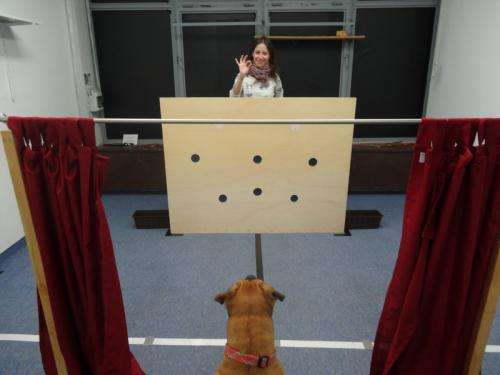May 7, 2014 report
Study suggests dogs able to follow direction of human voice

(Phys.org) —A team of researchers at the Max Planck Institute for Evolutionary Anthropology has devised an experiment that suggests that dogs are able to respond to the direction in which human voice moves. In their paper published in Proceedings of the Royal Society B: Biological Sciences, the team describes their experiments with multiple dogs and what their findings suggest.
Dogs and humans have a special relationship going back thousands of years. Scientists believe that over the course of all those years, it's possible that dogs have learned to communicate with people and vice-versa, in ways that aren't fully understood. One example was a prior study that found that dogs are able to follow a person's gaze, or in many instances a pointed finger. In this latest effort, the researchers sought to determine if dogs are also able to make inferences based solely on the direction in which human communications are traveling.
The experiment involved one human and one dog (at a time). The human kneeled behind a wood plank while the dog sat restrained behind a line several feet away, facing the wood plank. Between the two was a red curtain that served to prevent the dog from seeing the actions of the person. As the experiment began, the person stood up and showed the dog a food treat, instructing it to pay attention. The person then crouched down behind the plank as the curtain was drawn, grabbed one of two black smell-proof boxes and placed the food treat inside of it.
The boxes were then set at the edges of the plank, within sight of the dog when the curtain was opened. The human, still hidden behind the plank, changed position to directly face one of the boxes and spoke encouraging words to the dog. Then, the dog was released to fetch the treat. Adult dogs went straight to the correct box on average 7.6 times out of 12. With puppies used to being around people, the average was even better, 8.1 out of 12 tries. Puppies that had not been around people, however, did no better than chance.
More information: Federico Rossano, Marie Nitzschner, Michael Tomasello, Domestic dogs and puppies can use human voice direction referentially, Proceedings of the Royal Society B, 7 May 2014. rspb.royalsocietypublishing.or … .1098/rspb.2013.3201
Journal information: Proceedings of the Royal Society B
© 2014 Phys.org


















